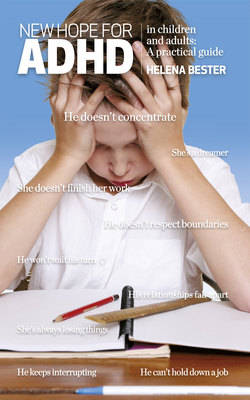Оглавление
Helena Bester. New hope for ADHD in children and adults
Foreword
Introduction
1
A typical picture – Pete’s story
The initial interview
Questions that could shed light
Questionnaire (behavioural checklist)
2
Part 1: Questions about ADHD. Confusion about terminology
What is ADHD?
How is ADHD diagnosed?
DSM-5 diagnostic criteria for ADHD
ADHD predominantly inattentive presentation
ADHD predominantly hyperactive-impulsive presentation
ADHD combined presentation
Does ADHD occur only in children?
What causes ADHD?
Are more boys than girls diagnosed with ADHD?
At what age is ADHD diagnosed?
What are the main symptoms of ADHD?
Other typical characteristics of ADHD sufferers
Impulsivity
Disorganisation
Literal or concrete mindedness
Rigidity
Poor linguistic skills
Overhastiness
Carelessness
Underachievement
Physical manifestations
Poor planning skills
Irresponsibility
Poor perseverance
Impatience
Temper tantrums
Aggressive behaviour
Self-centredness
Problems with boundaries
Talkativeness
Blaming behaviour
In summary
What should I know about stimulant medication?
Part 2: Conditions sometimes associated with ADHD
Oppositional defiant disorder (ODD)
Conduct disorder (CD)
Disruptive mood dysregulation disorder (DMDD)
Gilles de la Tourette syndrome
Mood disorders
Anxiety disorders
Intermittent explosive disorder (IED)
Drug dependence
Autism-spectrum disorder
Learning problems
3
The pain of mothers of ADHD children
Mindfulness
The basic principles of mindfulness
4
Clear rules and structures are important
The importance of rewards
A system of rewards
Possible rewards
Time out
Give clear instructions
Give one instruction at a time
Help them plan and organise
Keep your sense of humour
5
An evening chat
A focusing and relaxation exercise
Eye-movement exercises
Eye charts
Brain gym exercises
A visualisation exercise
Suggested daily programme
6
Do not hide behind the diagnosis
Always be a safe haven for your child
Base rules on principles
Reconsider your perspective
7
Starting school
The ADHD learner in the classroom
How to recognise the ADHD learner
Managing tips for the teacher. Placing
Homework
Time limits
Short, clear instructions
Clear structures
Establish an emotional bond
Get support
Be part of the solution
Referral procedures for the teacher
Referral of learners for support
Learning problems and ADHD
Inclusive education and the ADHD child
Home schooling
Private schools
8
Ritalin: advantages and disadvantages
Variations
Prescriptions and doses
Side effects
How Ritalin and other stimulants work
Concerns about the use of Ritalin
Generics of Ritalin
Concerta
Advantages
Strattera
Eating habits
Nutritional deficiencies and supplements
9
10
What is neurofeedback or neurotherapy?
How are goals determined?
What are the clinical uses of neurotherapy?
Brainwave frequencies: a brief explanation
Beta frequency (12-20 Hz)
Alpha frequency (8-13 Hz)
Theta frequency (4-7 Hz)
Delta frequency (1-3,5 Hz)
Gamma frequency (31-49 Hz)
Neurotherapy and ADHD
Alpha-theta treatment in neurofeedback
Preparing for alpha-theta treatment
Uses
The process
Experiences and sensations during alpha-theta treatment
Biofeedback can promote self-regulation
Breathing and biofeedback/neurotherapy
Breathing exercise
Skin temperature control exercise
Is neurotherapy safe?
The availability of neurotherapy in South Africa
The initial treatment
Does neurotherapy have a long-term effect?
Concluding remarks about brainwave regulation
An interesting case study
More success stories
11
General symptoms of ADHD in adulthood
Inattentiveness (group 1)
Hyperactivity and impulsivity (group 2)
12
13
The power of love
Acknowledgments
Bibliography
